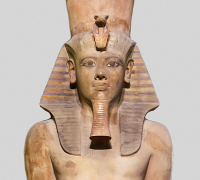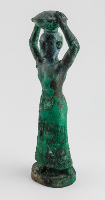Highlights from the Collection: Kings
Foundation Figurine of King Ur-Nammu
King Ur-Nammu rebuilt and enlarged one of the most important temples in ancient Mesopotamia - the E-kur of Enlil, the chief god of the pantheon. This figurine, which was buried in a foundation box beneath one of the temple towers, represents the king at the start of the building project - carrying on his head a basket of clay from which would be made the critically important first brick. The foundation deposit also contained an inscribed stone tablet; beads of frit, stone and gold; chips of various stones; and four ancient date pits found perched atop the basket carried by the king.
Trial Piece
It is uncertain whether this small relief is a student's practice piece or the unfinished work of a trained sculptor. Although the figure wears no royal insignia, it is probably the Pharaoh Akhenaten, depicted in the exaggerated style of the Early Period of Amarna art. The king's strange facial features-which served as a model for all human representations during his reign-include narrow slanting eyes, long nose, hollow cheeks, thick lips, and hanging chin. The sculptor has added incised lines to indicate the angle of the jaw and the crease that extends downward from the edge of the nose. Akhenaten wears a short 'Nubian' or military-style wig; the detailing of the curls has been left uncarved.
Colossal Statue of Tutankhamun
 Oriental Institute archaeologists working at Thebes excavated this statue of King Tutankhamun. It had been usurped by succeeding kings and now bears the name of Horemheb.
Oriental Institute archaeologists working at Thebes excavated this statue of King Tutankhamun. It had been usurped by succeeding kings and now bears the name of Horemheb.
Tutankhamun wears the double crown and the royal nemes headcloth of the pharaohs; a protective cobra goddess (uraeus serpent) rears above his forehead. In his hands the king grasps scroll-like objects thought to be containers for the documents by which the gods affirmed the monarch's right to divine rule. The sword at his waist has a falcon's head, symbol of the god Horus, who was believed to be manifested by the living pharaoh. The small feet at the king's left side were part of a statue of his wife, Ankhesenpaamun, whose figure was more nearly life-sized.
The facial features of this statue strongly resemble other representations of Tutankhamun from his famous tomb, which was discovered relatively intact in the Valley of the Kings.
Bronze Band
 The fortress of Sargon II at Khorsabad included a complex of temples, one of which was devoted to the sun god Shamash. This bronze band encircled one of a pair of cedar poles-possibly supports for divine emblems-that once flanked the doorway to this temple. The band was affixed to the pole by nails driven through the centers of the rosettes that decorate the three narrow bands framing the two main registers.
The fortress of Sargon II at Khorsabad included a complex of temples, one of which was devoted to the sun god Shamash. This bronze band encircled one of a pair of cedar poles-possibly supports for divine emblems-that once flanked the doorway to this temple. The band was affixed to the pole by nails driven through the centers of the rosettes that decorate the three narrow bands framing the two main registers.
In the upper register, Sargon is shown grasping two massive bulls by the horns. This ancient motif, known as "the master of animals," was well established in Mesopotamian royal iconography and perhaps symbolized the dominance, vitality, and potency of the reigning monarch. To the left of the king and bulls is a large bird depicted in flight, to the right, facing the king and bulls, is an attendant wearing a kilt. In the lower register, only a fig tree and the tip of a plough are preserved.
King Ashurnasirpal II
Room G in Ashurnasirpal II's palace may have served as the setting for a ritual by which weapons were purified. The walls of this chamber were adorned with exceptionally well-carved and minutely detailed reliefs showing the king standing between, alternately, two courtiers and two winged genies. This fragment shows the king himself, identifiable by his fez-shaped cap surmounted by a conical spike. Originally, this piece formed part of a scene. The king, grasping a bow, stood ready to pour a libation from a cup poised delicately on the tips of his fingers. Facing him was an attendant who carried a fly-whisk with which to banish insects from the royal presence.




